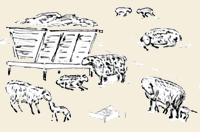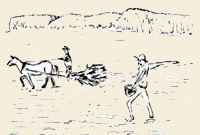
Spring 2005

 |
|
 |
| Home | Index | Museums | Blog | Authors | Site Map | About |
|
On May 21, the New Society of the Genesee met at the Caledonia Inn to hear Gary Lehmann of RIT tell us about shoemaking in upstate New York during the 1830s. In case you missed it, the following is a brief summary of his talk. The Lyle Tyler Shoe Shopat the Genesee Country MuseumbyGary LehmannAbout four years ago, Dan Barber, Chief Curator at the Genesee Country Museum asked me to take a fresh look at the Lyle Tyler Shoe Shop currently situated in the Village Square at the Genesee Country Museum, but originally located in East Avon across from the White Horse Tavern. When it was located at the intersection of Routes 5 & 20 and the Rochester-to-Geneseo Road, the shop was set back from the road. It was originally built for a lawyer who, supposedly, ran off with funds after a big land transfer in 1829. His horse returned, but he did not. The building stood empty for some time before a shoemaker named Lyle Tyler occupied it for the purpose of setting up what was then called a "shoe factory." Located between a tavern and a church, it was perfectly situated. The interior of the structure has two simple rooms and windows and doors on all but one side. The main room is about twelve feet square. Into this small space, Tyler placed several shoemakers, each with enough space to stretch out his arms without hitting a fellow worker. Some shelves would have displayed model shoes. When the Museum was first being configured in the early 1960s, this building was one of the first in the Village Square. The shoemaking equipment on display in the shop covered the entire range of 19th century tools from imported English hand tools made in Sheffield, England to a cast iron shoe shine stand from the very end of the century. The shop had not been significantly reinterpreted in 40 years. The idea was to pick an appropriate date and reinterpret the shop with that exact date in mind. One date stood out: 1837. This is the date of the economic panic which was caused by the manipulation of the value of the currency from Washington. Since the shoemaker operated his business almost entirely with cash, the sudden scarcity of hard currency put most shoemakers out of business. When the economy revived, about 1840 or '41, wealthy Massachusetts shoe manufacturers had taken advantage of the lull in trade to establish themselves as national distributors of cheap shoes made in large factories by water-driven machinery. Therefore, we decided upon 1837 as our interpretive date for the Lyle Tyler Shop, because it stands out as the high water mark of handmade shoe production in this region. After 1837, shoemakers in Rochester fought a losing battle against lower quality shoes that arrived every day on the canal barges. So, every object in the shop that post-dates 1837 had to go. That limited us considerably. On the other hand, shoemaking tools dating back to the 18th century could remain, since shoemakers repaired and cherished their tools for generations. One consequence of choosing 1837 was that all of the cobbling equipment, regardless of date, had to be packed up and expelled from the shop. In hard times, shoemakers got into repair and sales, but in the prosperous days of the early 1830s, shoemakers made shoes. Period. Cobbling was an itinerant trade practiced by rootless individuals with a cart or a wagon. They were poorly paid men who frequently combined shoe repair with peddling. Shoe makers, by contrast, were family men. They lived in villages, were well-paid, worked indoors, and were well-respected members of the community. The shoemaker was a tradesman with plenty of business that kept his income above average. The master shoemaker had to treat his journeymen with care if he wanted to keep them on the job. His lot in life could not have been much different from the cobbler who roamed from town to town. The work done in the shoemaker’s shop can be divided into distinct sub-trades. Tanning was generally separated from the shoe shop, because the smells generated by tanning pretty much mandated that it be practiced outside of the town limits. Shoemakers got their leather on credit and paid when the shoes were sold. Cowhide was most common, but shoes were also made of squirrel skins, goat hide, and lamb skin. New England trade with Eskimos even brought seal skin to this area in the 1830s. There were three classes of workers in an upstate New York shoe factory, Clickers, Peggers and Finishers. The Clicker was an expert at cutting out leather in various patterns to suit a variety of sizes and styles. The sewing was done outside the shop. It was parceled out in batches of a dozen shoes per basket. These were picked up by local women interested in making cash wages, but the work had to be done at home, because, as everyone understood, women and men do not work in the same place. It would be unseemly. The Peggers lasted the shoe [i.e. attached the completed leather upper to the wooden form that retains the shape of the foot while the shoe is being built], and then pegged the shoe to attach the various layers of leather that make up the sole and heel. After 1825, American shoes were made with square wooden pegs that sort of stapled the shoe together. They were generally made of maple, squared off to 1/11th of an inch and pointed at 5/8ths of an inch. Over 150 pegs go into attaching the 10 or so layers of leather that make up the sole and heel of a pair of work shoes called Brogans. Men also wore walking shoes with the tops below the ankle, and some men had dancing shoes which were made like oversized women's slippers. Women had more pairs of shoes than men, according to probate records, and their shoes were more delicately made. Most women's shoes were sewn and many were turn shoes, like the men's dancing shoe. Unlike the sturdy work shoe, the dancing slipper is sewn inside out and then turned after being soaked in warm water. This procedure hides the sewing inside the shoe around the edges. The Finisher would have been the third class of worker in Lyle Tyler’s factory. After the shoe is lasted and pegged or sewn, the Finisher adds the shine to the sole bottom with a plant-based mucilage, and details the sole edges with shoe blacking. Then, he polishes scuffs out the finished product with acids and pastes. The last two figures in the shop were the master and the boy. The role of the master was to sell the shoes, keep track of the money, pay wages and suppliers, and keep his workers happy enough to resist the lures of the West. The boy opened the shop early each morning, set the fire, and prepared the shoe wax for the day's production. During the day, he chopped wood, carried water, sorted hides, and read books and newspapers to the workers to occupy their minds while their hands were busy making shoes. In between, he learned the trade. By the time he was 16, he could expect to become a journeyman and take home a living wage. In the meantime, he had to settle for a few pennies a day and his dreams of a bright future. Locating tools for the shop was a time-consuming job which took me to hundreds of antique shops and garage sales. Despite the importance of the trade in the 19th century, few antique dealers have the slightest idea of what a shoemaking tool looks like. Being relatively valueless today, they are not worth a dealer's time. The good news is that most of the tools we needed were available in upstate New York, once we found them in whatever obscure location they landed after a lifetime or more of daily use. In order to understand the trade from the inside out, I proposed to learn shoemaking from anyone I could find who still practiced it. There is a very fine website called The Crispen Colloquy located at [http://www.thehcc.org/discus/messages /board-topics.html], but in order to get real hands on experience, I contrived to spend several weeks with Peter Oakley, Chief Shoemaker at Sturbridge Village. Peter makes men's walking shoes and heavy-duty military boots. I also wanted to learn how to make the more delicate women's shoes. So, I convinced Dan Carpentier, the honorary mayor of East Field Village outside of Albany, to offer a course in turn shoe construction. Oddly enough, there are no books on shoemaking in the 19th century. The trade was very jealous of its secrets. One of the reasons for separating each skill by worker was to safeguard the mysteries of the entire craft from any but the mind of the Master. This more or less guaranteed that only shoemaker-made shoes would last, thus retaining the value of the trade. Someday, I'd like to write down what I have discovered, but for the time being, the best text I can offer is a trip to the Lyle Tyler Shoe Shop at the Genesee Country Museum. CLR Blog | Site Map | Contact CLR |